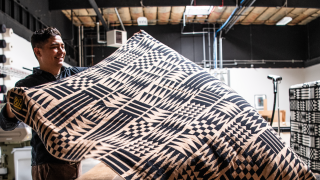Walk through a major clothing or home goods shop in the U.S., and you’re likely to see something that appears to come from Native American culture: patterned blankets or jackets, towels, T-shirts or jewelry. Dig a little deeper, and you’ll find much of it wasn’t created by Native artists. What's more, to justify their profits from these products, many retailers use misleading labels with words like “Native-inspired,” tell half-truths about working closely with tribes or claim to honor Indigenous cultural traditions.
For independent, Native artists like Sarah Agaton Howes, who is Anishinaabe and renowned for her Ojibwe designs, that level of corporate competition can feel limiting. “For so long, the only Native art in bulk that was out there was stolen geometric art,” she told NBCLX.
A new generation of Native American artists
Just a few years ago, Howes thought she’d only ever sell her custom quilts and moccasins within her rural community of 20,000 and through tribal connections in the Midwest. Today, she’s one of the most successful Indigenous, commercial artists in North America.
As more people become aware of cultural appropriation, art-world theft and other forms of racism against Native Americans, there's a burgeoning movement of Indigenous artists focused on entrepreneurship and designing their own futures.

“I can build the kind of business that I feel is important, something that really falls in line with ... my own cultural values,” Howes said.
Her business, Heart Berry, which sells blankets, earrings, T-shirts and more has doubled year over year, making it one of the fastest-growing lifestyle brands in Minnesota. She says running her business is familiar territory as a Native American.
“We’ve always been barterers, but somewhere along the line, we developed the line that we aren't business people,” said Howes. “We’ve always been creative, we’ve always adapted.”
Native American-made art goes mainstream
To boost Howes' and other Native artists' confidence as entrepreneurs, artist and Nooksack Tribe member Louie Gong started an initiative called Inspired Natives in 2014. As part of Gong's art and lifestyle brand Eighth Generation, which he sold to Washington state's Snoqualmie Tribe in 2019, Inspired Natives helps Indigenous artists meet demand for their work, with the goal of making Native-made and designed products more popular than so-called Native-inspired alternatives.
“Outside support didn’t exist when I started [in 2007] for cultural artists trying to make their art work as business,” Gong told NBCLX. ("Cultural artists" refers to Native artists whose work is rooted in traditional art and storytelling.)
Inspired Natives' strategy of providing business resources to Native artists, who then produce work under the Eighth Generation brand name, has been highly successful as of late. In the past 30 days, Eighth Generation's sales are up 120% compared to the same month last year, and royalties paid to the artists often exceed the median income in their states, according to Gong. Eight Generation's products are also featured in this year's Starbucks holiday merchandise, including a wool blanket and ceramic tumbler.
The problem now is that other companies are trying to co-opt the model, and when non-Natives collaborate with Native artists, they tend to lean on stereotypes that portray Indigenous peoples as historical figures or symbols of nature or charity, Gong said.
“The pattern of these companies that exploit Indigenous communities is to partner with people who don’t have a voice,” Gong said. “Native artists are trying to reclaim the story and create something for future generations.”
Fighting back for the future of Native American art
Gong and Eighth Generation have also tried to put pressure on businesses like Pendleton Woolen Mills, a Portland, Oregon-based textile company that's been criticized in the past for its famous Native motifs, to change their approach. Gong accused Pendleton, run by a white family for six generations, of leveraging Native stories and aesthetics to profit off “fake Native art.”
In response, a Pendleton spokesperson told NBCLX via email that it "partners with Native American designers each season to develop new designs, and reissues vintage patterns from the archives. For 2021, the Pendleton line features artwork by 12 artists who receive payment and recognition on all marketing materials for their designs."
Addressing accusations of cultural appropriation, the spokesperson said: "Pendleton has been a proud supplier of blankets to the indigenous community since 1909. The blankets and fabrics feature designs that appeal to those first customers, and reflect the colors and patterns of the landscapes."

Indigenous communities' taking control of their art has also rocked the antiquities-collecting world, from auction houses to dealers, thieves and powerful museums, who’ve historically profited off sacred, Native items.
“Tribes have and continue to have a lack of capacity to fight these dealers in auction houses who continue to auction stolen items,” said Shannon O'Loughlin, a citizen of the Choctaw Nation of Oklahoma and chief executive of the Association on American Indian Affairs, the oldest non-profit in the U.S. working within tribal communities to preserve cultural heritage.
The good news is a growing awareness of the abuse Indigenous people have faced, as well as laws that require cultural items be returned to Native descendants, mean that antiquities dealers are finding it harder to sell Native art, objects and clothing, O'Loughlin told NBCLX.
Interested in supporting Native American art? O'Loughlin advised skipping auction houses altogether and instead buying from current Indigenous artists. That way, you know you're not accidentally purchasing a sacred object illegally, and your dollars are going to artwork that's Native-made, not Native-inspired.


